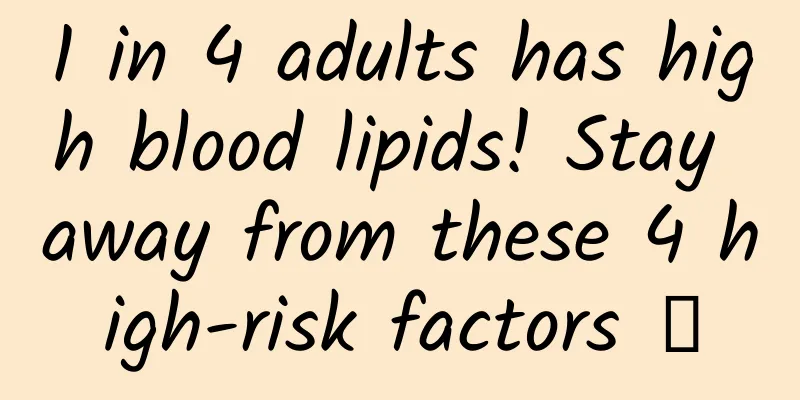1 in 4 adults has high blood lipids! Stay away from these 4 high-risk factors →

|
When it comes to high blood lipids, even young people are familiar with it, right? In the past, this disease was more common among the elderly, but now young people are suffering from high blood lipids. The "Report on the Nutrition and Chronic Disease Status of Chinese Residents (2020)" shows that the overall prevalence of hyperlipidemia among residents aged 18 and above in my country is as high as 35.6%, which is a high proportion! This is equivalent to 1 in every 3 to 4 adults suffering from hyperlipidemia. Many people believe that high blood lipids are caused by eating too much cholesterol food, and it is better to eat less or not eat it. Is it really that simple? In this article, let's talk about high blood lipids and cholesterol. Let me start with the conclusion: If you are healthy and have normal blood lipids, you can just eat a balanced diet and don’t need to worry too much about cholesterol. But if you already have high blood lipids, it is necessary to adjust your diet and control your cholesterol intake. Cholesterol? It's not just what you eat. In order to prevent themselves from suffering from high blood lipids, many people will deliberately control the intake of cholesterol in their diet, thinking that as long as they consume less cholesterol in their diet, they can avoid high blood lipids, and even think that cholesterol is a harmful component to the body. In fact, this view is inaccurate. First of all, we cannot simply think that cholesterol is a "bad thing". On the one hand, cholesterol is very important to us. It is an important component of cell membranes and we really cannot live without it. On the other hand, cholesterol is the synthetic material of many important active substances in the human body, such as bile, sex hormones, adrenaline, etc. It can also be converted into 7-dehydrocholesterol in the body, which can be converted into vitamin D in the skin after ultraviolet radiation. For healthy people, consuming more cholesterol may not have a big impact. Because in addition to intake through food (exogenous cholesterol), the human body can also synthesize cholesterol (endogenous cholesterol). The absorption rate of cholesterol ingested through food is about 30%, and the remaining 70% comes from self-synthesis. The amount of cholesterol synthesized by the body every day is about 1000 mg, which is much higher than the amount of cholesterol we ingest from food. The body's ability to synthesize cholesterol is affected by many factors, such as the type of dietary fat intake, thyroid hormone levels, estrogen levels, insulin levels, and the amount of cholesterol intake in the diet. There is a self-regulating mechanism for cholesterol levels in healthy people. If more cholesterol is consumed in the diet, the body's own synthesis of cholesterol will decrease; if less cholesterol is consumed in the diet, the body's own synthesis of cholesterol will increase, keeping the body's cholesterol level in balance. Therefore, based on current evidence, there is no need to strictly limit cholesterol intake for healthy people. How does high blood lipids come about? Since it has little to do with the cholesterol we eat, how does high blood lipids come about? Hyperlipidemia usually refers to elevated levels of cholesterol and/or triglycerides in serum. There are four clinical situations that can be diagnosed as hyperlipidemia. Figure: "Dietary Guidelines for Adults with Hyperlipidemia (2023 Edition)" As mentioned above, high blood lipids cannot be simply attributed to eating too much cholesterol. It is mainly caused by an unreasonable diet. The risk factors that easily induce high blood lipids in the diet mainly include the following four: 1. Bad fats Saturated fat and trans fatty acids are both "bad fats". If you eat too much of them on a daily basis, it will increase the level of low-density lipoprotein cholesterol in your body. This is a bad cholesterol that can easily form plaques on the walls of coronary arteries and other arteries, narrowing the blood vessels and hindering blood circulation. It is directly related to the occurrence of atherosclerotic cardiovascular disease. Copyright images in the gallery. Reprinting and using them may lead to copyright disputes. 2. Added Sugar Added sugar refers to the sugar that is artificially added to food in addition to the sugar contained in the food itself. For example, when we eat a sweet apple, it is the sugar contained in the apple itself, not added sugar. But in order to make this apple into an apple pie, we add a lot of sugar in the middle, which is added sugar. A study published in JAMA shows that excessive intake of added sugar will increase triglycerides, cholesterol, and low-density lipoprotein cholesterol (bad cholesterol) in the blood, and cause a decrease in high-density lipoprotein cholesterol (good cholesterol). 3. Refined rice and white flour This type of staple food is refined carbohydrates. Eating it will cause blood sugar to rise rapidly after a meal, promote insulin secretion, and promote the synthesis of triglycerides, thereby increasing the risk of hyperlipidemia. 4. Alcoholic Beverages The "Guidelines for the Prevention and Treatment of Dyslipidemia in Chinese Adults (2016 Revised Edition)" and the "Dietary Guidelines for Adults with Hyperlipidemia (2023 Edition)" clearly state that although moderate drinking can increase high-density lipoprotein cholesterol, even small amounts of drinking can further increase triglyceride levels in patients with hypertriglyceridemia, which is not conducive to cardiovascular health. It can be seen that preventing high blood lipids is not as simple as eating less cholesterol! There is still controversy about the relationship between cholesterol intake, blood lipid metabolism and the risk of death from cardiovascular disease. Healthy people do not need to "insulate" themselves from cholesterol in order to avoid high blood lipids. High blood lipids are not caused by eating too much cholesterol in the diet. The key is to reduce the intake of saturated fatty acids, trans fatty acids and added sugars. Save "high blood lipids", eat like this Don't underestimate high blood lipids, which are an important risk factor for hypertension, diabetes, coronary heart disease, and stroke. Long-term hyperlipidemia can lead to atherosclerosis and increase the incidence and mortality of cardiovascular diseases. In addition, a large prospective study published in the top medical journal "Journal of the American College of Cardiology" showed that if you have high blood lipids and high low-density lipoprotein cholesterol levels between the ages of 18 and 30, you will have a higher risk of cardiovascular disease in middle and old age. If you already have high blood lipids, how should you eat? 1. Limit total fat and saturated fat intake Many foods are high in total fat and saturated fat, and they are often high in cholesterol, which is harmful to health. Therefore, we should follow common sense and remember to eat less oily and greasy foods. In addition, foods such as animal brains and animal offal often have high cholesterol, so we should also eat less of them. 2. Eat more soy products Soy products contain plant sterols, which have a low absorption rate in the intestines and can interfere with and inhibit cholesterol absorption. Tofu, dried tofu shreds, yuba, low-salt dried tofu, and sugar-free soy milk are all good choices. 3. Eat more whole grains, beans, vegetables and fruits Whole grains, beans, vegetables and fruits are rich in dietary fiber. Dietary fiber combines with bile acid in the intestines to reduce the absorption of lipids, thereby lowering blood cholesterol levels. At the same time, high dietary fiber can reduce blood insulin levels, increase human insulin sensitivity, and help regulate lipid metabolism. Copyright images in the gallery. Reprinting and using them may lead to copyright disputes. Recommended whole grains include oatmeal, brown rice, corn, millet, quinoa, black rice, highland barley, sorghum, etc. Among beans, mung beans, red beans, chickpeas, black beans, and kidney beans are all good choices. Eat 500 grams of fresh vegetables every day, more than half of which should be dark vegetables, such as broccoli, purple cabbage, carrots, and colored peppers. Eat 200-350 grams of fruit every day. It is recommended to choose low-sugar fruits, such as grapefruit, pears, strawberries, and blueberries. 4. Eat a light diet Strictly control the intake of fat, sugar, and salt. The intake of oil should not exceed 25 grams per day. Cooking oils rich in n-3 unsaturated fatty acids, such as flaxseed oil and perilla seed oil, are especially recommended. Avoid consuming oils high in saturated fatty acids, such as lard, butter, and coconut oil. The intake of salt should be controlled to no more than 5 grams per day. At the same time, eat less high-salt foods such as soy sauce, chicken essence, MSG, pickles, bacon, and pickled vegetables. Eat less sweets, reduce the intake of added sugar, and do not drink fruit juice. In addition, it is also important to control your weight. Overweight and obesity are not only risk factors for dyslipidemia, but also easily induce other chronic diseases. Summarize: The main cause of hyperlipidemia is not too much cholesterol in the diet. The cholesterol level in human plasma is not the same as the cholesterol intake in the three meals. Healthy people do not need to restrict cholesterol intake too much, as long as they follow the Chinese Residents' Balanced Diet Pagoda. For people who already have hyperlipidemia, it is necessary to limit cholesterol intake. References [1] Sun Changhao. Nutrition and Food Hygiene. 8th edition. People's Medical Publishing House. 2018 [2] Chinese Nutrition Society. Dietary Nutrient Reference Intakes for Chinese Residents (2023 Edition) [M]. People's Medical Publishing House. 2023.8 [3]Welsh, Jean Aetal. "CaloricsweetenerconsumptionanddyslipidemiaamongUSadults." JAMAvol.303,15(2010):1490-7.doi:10.1001/jama.2010.449 [4] Domanski, Michael Jetal. "TimeCourseofLDLCholesterolExposureandCardiovascularDiseaseEventRisk." JournaloftheAmericanCollegeofCardiologyvol.76,13(2020):1507-1516.doi:10.1016/j.jacc.2020.07.059 [5] Yang Yuexin. Chinese Food Composition Table 6th Edition Volume 2[M]. Peking University Medical Press, 2019 This article is a work of Science Popularization China-Starry Sky Project Produced by: Science Popularization Department of China Association for Science and Technology Producer|China Science and Technology Press Co., Ltd., Beijing Zhongke Xinghe Culture Media Co., Ltd. Author: Xue Qingxin, registered nutritionist Reviewer: Ruan Guangfeng, Director of Science and Technology Department, Kexin Food and Nutrition Information Exchange Center |
<<: Get more sun, it really can make you happier!
>>: Is it good to drink water before bed?
Recommend
How can women replenish blood through dietary therapy?
As we move towards a well-off society, we only ca...
Can gynecological regeneration pills treat amenorrhea?
Gynecological Rejuvenation Pills are a very typic...
Does your girlfriend have a strong body odor?
If a woman has an unpleasant odor from her privat...
Early pregnancy reaction watery leucorrhea
Women's lower body usually has leucorrhea and...
Side effects of metoclopramide in women
With the development of modern society, more and ...
Why does breast pain occur during weaning?
Although breast milk is the main source of nutrit...
What is the reason for the tips of the dragon blood tree leaves to turn yellow and dry? How to remedy the yellow and dry tips of the dragon blood tree leaves
Dracaena is very common among household flowers. ...
Can Ibuprofen sustained-release capsules be taken during breastfeeding?
Ibuprofen sustained-release capsules are a non-st...
Itchy lower body after abortion
Whether before or after an abortion, female frien...
What should I do if my aunt has back pain?
Many complications often occur when menstruation ...
What is the best time to test for pregnancy?
Before preparing for pregnancy, women need to und...
What to eat for liver detoxification in women
For women, if they do not take proper care of the...
Types of uterine fibroids
Uterine fibroids are a relatively common disease,...
Does pelvic effusion really affect pregnancy?
Pelvic effusion is a common symptom in women, whi...
Symptoms of lumbar muscle strain in women
Hello everyone, today we are going to talk about ...









